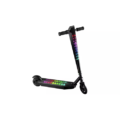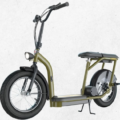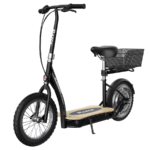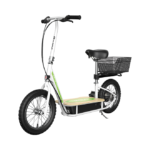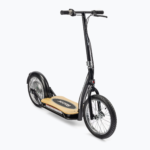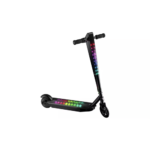- Home
- Scooters
- Electric Scooters
- Razor EcoSmart Metro
Razor EcoSmart Metro


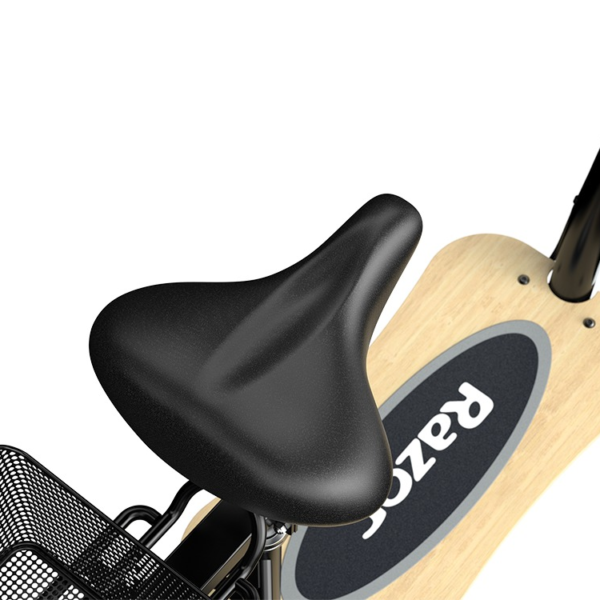

- Battery Range: 12 mi (19 km)
- Top Speed: 18 mph (29 km/h)
- Motor Power: 500 W nominal
- Weight Capacity: 220 lb (100 kg)
- Charging Time: ~6–7 h
- Scooter Weight: 65.0 lb (29.5 kg)
PROS
- Seated comfort + bamboo deck
- 16″ pneumatic tires smooth streets
- Stable handling at city speeds
- Basket/rack friendly for errands
- Simple, low-fuss maintenance
CONS
- Heavier than stand-up commuters
- Larger storage footprint
- Pneumatics need pressure checks
- Range varies with speed/hills


Table of contents
- What Is the Razor EcoSmart Metro?
- How the Razor EcoSmart Metro Works
- Key Specifications
- Design & Build Quality
- Performance Fundamentals
- Battery, Range & Efficiency
- Ride Quality & Comfort
- Braking & Safety Features
- Portability & Daily Usability
- Maintenance & Care
- Weather & Seasonal Considerations
- Razor EcoSmart Metro vs Alternatives
- Who the Razor EcoSmart Metro Is (and Isn’t) For
- FAQs
- Glossary
- Final Notes on the Razor EcoSmart Metro
The Razor EcoSmart Metro is a seated electric scooter built for steady, low-stress neighborhood travel and short urban errands. It combines a wide bamboo deck, bicycle-style wheels, and a simple twist throttle to deliver a relaxed, confidence-building ride. Because it favors stability over speed, it suits riders who value comfort, practicality, and easy maintenance more than sprint times.
What Is the Razor EcoSmart Metro?
At its core, the Razor EcoSmart Metro is a sit-down e-scooter with a steel frame, wide platform, and large pneumatic tires. Unlike compact stand-up commuters, it rides more like a small utility bike that happens to be electric. Consequently, it feels familiar within a few minutes, even if you have not ridden an e-scooter before.
The scooter’s signature look comes from its bamboo deck and upright seat post. Together, they create a casual riding posture that encourages smooth starts, steady cruising, and confident cornering. Moreover, the bicycle-style wheels roll over cracks and gravel with far less drama than the tiny tires found on many lightweight kick-scooters. Because the design is simple and robust, it also handles day-to-day bumps without requiring elaborate service routines.
Finally, the Razor EcoSmart Metro targets practical trips. Think grocery runs, campus commutes, and weekend rides to the café. It is not built to fold into a backpack or to win drag races. Instead, it’s designed to feel predictable, carry a small bag or basket, and get you across town with minimal fuss.
How the Razor EcoSmart Metro Works
Motor. The EcoSmart Metro uses a straightforward drive system paired to the rear wheel. You twist the throttle, power flows from the battery through the controller, and the motor turns the drivetrain. Because the gearing favors smooth, casual acceleration, launches feel controlled rather than snappy. On flat ground, the scooter reaches a comfortable neighborhood pace without drama.
Controller. The controller is the “traffic cop” for electricity. It meters current so the motor receives only what you command at the throttle. Therefore, partial-throttle cruising is easy and efficient. When you roll on more, the controller adds power smoothly. As a result, there’s no need to “blip” the throttle to find a comfortable speed.
Battery. A 36-volt sealed lead-acid (SLA) pack is common on this model family. SLA chemistry is rugged and budget-friendly, and it likes to be kept at or near full charge. Because of that, it’s wise to top up after rides and avoid deep discharges. You do trade some weight and cold-weather range compared with lithium packs, yet day-to-day reliability remains solid if you charge consistently.
Throttle. The twist-grip throttle acts like a volume knob for speed. Turn a little for a slow roll. Turn more for a brisk pace. Since the response is progressive rather than jumpy, new riders can modulate speed accurately within a block or two.
Brakes. A hand lever actuates a mechanical brake at the rear wheel. The lever feel firms up about halfway through the pull, which delivers usable feedback before full lock-up. On dry pavement, stopping is steady and predictable. In wet conditions, braking distances lengthen, so it’s smart to cover the lever earlier and leave more room.
Key Specifications
The table below organizes core details by theme. Because versions and regional packages vary, always verify the exact configuration of your unit’s labeling and manual.
| Block | Details |
|---|---|
| General | Category: Seated electric scooter with wide bamboo deck and steel frame. Wheel style: Bicycle-type, pneumatic tires. Intended use: Short urban errands, campus travel, neighborhood cruising. |
| Performance & Power | Motor class: Rear-drive system tuned for smooth, neighborhood-pace cruising. Acceleration: Progressive, beginner-friendly roll-on; not tuned for sprints. Hill behavior: Manages gentle grades with a running start; speed drops on steeper climbs. |
| Battery, Charging & Electrical | Battery: 36-volt sealed lead-acid pack (typical for this model family). Charging: External charger; plug in after rides; “overnight” top-offs are common. Electrical features: Basic, ride-focused layout; no app dependencies. |
| Build & Dimensions | Frame: Welded steel with upright seat post. Deck: Bamboo platform with ample foot room. Folding: One-piece design; not a quick-fold scooter. Folded dimensions: N/A (handlebar/seat components can be removed with tools, but the scooter does not quick-fold). |
| Safety & Control | Brake: Hand-operated rear mechanical system with firm bite mid-lever. Lighting: Many packages ship without integrated lights; reflectors may be included; add lights for dusk/night. Water resistance: No official IP rating; ride conservatively in wet conditions. |
| Features & Extras | Seating: Padded seat with upright posture; rear cargo rack/basket often included in bundle packages. Kickstand: Side stand for quick parking. Cruise Control: Not included. |
| Warranty & Compliance | Warranty: Limited manufacturer warranty; terms vary by region and seller. Compliance: Product labeling indicates applicable regional standards; follow local riding laws and equipment requirements. |
Design & Build Quality
The EcoSmart Metro’s build emphasizes simplicity and durability. The welded steel frame is stiff in the right places, so the scooter feels planted over rough patches. Meanwhile, the bamboo deck gives your feet a broad, flat surface and a little vibration damping. The deck’s width also lets you vary stance and relieve pressure on long rides.
Up front, the cockpit layout is straightforward. You get a twist throttle on one side and a brake lever on the other, with easy reach from a neutral grip. There are no crowded switchpods or hidden menu systems to learn. Because cables and wiring are exposed in a bike-like manner, inspection and routine adjustments are direct.
Fit-and-finish is functional. Welds are tidy, fasteners are standard, and replacement touch points—grips, saddle, tires—are widely available in the general bicycle ecosystem. As a result, most wear items can be refreshed without brand-specific tools. The kickstand deploys with a light tap and holds the scooter upright securely. Even after many curb cuts and driveway transitions, the chassis keeps its line without odd creaks or rattles when the fasteners are kept snug.
Performance Fundamentals
Acceleration feel. Roll on the throttle and the EcoSmart Metro eases forward rather than snapping your head back. This is intentional. Because torque arrives progressively, traction stays predictable on smooth or sandy pavement. When crossing intersections, you can meter power precisely. In a crowded lot, you can creep along at walking speed without surging.
Cruising stability. The large pneumatic tires are the star here. They bridge cracks, expansion joints, and shallow potholes that would unsettle small-wheel scooters. Moreover, the longer wheelbase and seated posture keep weight centered. Consequently, the scooter tracks straight on imperfect pavement and holds a calm line at neighborhood speeds.
Hill-climb behavior. On mild grades (~7% range), the EcoSmart Metro climbs steadily with a rolling start. It may slow on steeper hills (~10% range), especially with heavier riders or headwinds. Because it prioritizes comfortable gearing, the trade-off is clear: confident flats and mellow hills over punchy, high-power climbs. Planning a run-up and maintaining momentum helps. If you stop mid-slope on a steep section, expect a gradual restart rather than a snap back to speed.
Battery, Range & Efficiency
Rated vs. real-world. Lead-acid systems deliver reliable energy when you keep them topped up. However, real-world range varies more than lab figures suggest. Rider weight, start-stop traffic, headwinds, tire pressure, and temperature all matter. In practice, a relaxed, steady cruise extends range noticeably compared with repeated full-throttle bursts. Because the Razor EcoSmart Metro is tuned for moderate speeds, efficient pacing comes naturally.
Temperature effects. SLA chemistry loses punch in the cold. Therefore, winter rides shorten range and dull acceleration. In heat, capacity recovers, but battery longevity can suffer if stored fully charged in hot spaces. Store the scooter in a cool, dry place. Let the battery cool to room temperature before charging after a hot ride.
Charging best practices. Charge after each outing, even short trips. Avoid leaving the pack deeply discharged, because SLA batteries dislike sitting low. During long storage, top up regularly to prevent sulfation. Because slow, complete charges are gentler, “overnight” routines work well. Finally, check that charging cables are seated fully, and keep the charger off the floor to reduce dust intake.
Efficiency tips. Maintain proper tire pressure, ease onto the throttle, and anticipate stops so you brake less and coast more. Because chain and brake drag nibble away at range, a quick monthly check and lube pay off quickly. Small habits compound into noticeably longer rides.
Ride Quality & Comfort
Comfort is the EcoSmart Metro’s calling card. The padded saddle and bicycle-sized pneumatic tires absorb chatter that would travel straight through solid micro-scooter tires. Although the scooter lacks suspension components, air volume in the tires provides meaningful compliance. Therefore, even gravelly lanes feel manageable when you keep your speed modest and your line smooth.
Ergonomics. The upright posture fits casual travel. Hands fall naturally to the grips, and your torso stays neutral. Because the deck is wide, you can reposition your feet rather than locking into a narrow stance. Long rides remain comfortable if you vary foot pressure and take brief standing breaks at lights.
Stem flex. The bike-style front end is stout for this class. Some flex exists—steel always flexes a little under load—but there’s no vague or rubbery feel in typical use. If you notice a change after months of riding, it usually means fasteners need a torque check rather than structural wear.
Noise and vibration. Mechanical hum is part of the character, yet there’s no harsh buzzing at cruising speed when the chain is clean and tensioned. Over rough asphalt, tire squirm and frame resonance stay controlled. Because the seat post can creak if dry, a touch of assembly paste at service intervals keeps it silent.
Braking & Safety Features
The rear mechanical brake provides the primary stopping force. Lever feel firms up halfway through the pull, so you can sense grip rising before the tire skids. Practice threshold braking in a quiet lot to learn the bite point. In the rain, start braking earlier and modulate gently, since water reduces friction at the contact patch.
Regenerative braking. There is no electronic regen on the EcoSmart Metro. Consequently, all slowing force comes from the mechanical system and rolling resistance. Because of that, pads and cables deserve routine attention.
Lights and reflectors. Many configurations ship without integrated lights. Add a bright headlight, a steady tail light, and reflective side accents if you ride at dawn, dusk, or night. Even at midday, a blinking tail light increases conspicuity near driveways and crosswalks.
IP rating and wet riding. There is no official IP rating. Therefore, treat puddles, heavy rain, and flooded paths as no-go zones. If you do encounter light rain unexpectedly, reduce speed, avoid standing water, and dry the scooter after the ride. Wipe connectors and the chain, then re-lube once the metal surfaces are dry.
Portability & Daily Usability
The Razor EcoSmart Metro favors ride comfort and utility over compactness. It does not quick-fold, and it is heavier than slim stand-up models. As a result, carrying it up multiple flights of stairs is a workout. Ground-level storage, garages, sheds, or first-floor hallways make the most sense.
Parking and security. Always use the kickstand on level ground and turn the front wheel slightly toward the curb to reduce roll-off risk. For security, a quality U-lock and a secondary cable for wheels or rack add deterrence. Because the scooter resembles a small bike, it parks well at bicycle racks where allowed.
Daily habits. Keep the charger near your regular parking spot so plugging in becomes automatic. Mount a small bell to alert pedestrians on shared paths. Add a rear basket or pannier if your configuration includes the rack, and use a bungee net to keep items from bouncing out.
Maintenance & Care
A little care keeps the EcoSmart Metro riding smoothly for years. Because its systems are simple, the routine is mostly bicycle-style.
Tire pressure. Check pressure weekly and adjust according to the tire’s sidewall guidance and your weight. Slightly lower pressures improve comfort and wet grip, while higher pressures roll farther and resist pinch flats. Do not exceed the printed maximum.
Brake adjustment. As pads wear, the lever travel grows. Turn the barrel adjuster at the lever for small corrections, and use the caliper’s adjustment for larger resets. If the lever feels spongy after rain, inspect housing and cable ends for moisture ingress or frayed strands.
Chain care. Wipe the chain with a dry rag after dusty rides. Then apply a light bicycle-chain lubricant and spin the wheel to distribute it. Because clean chains run quieter and transmit power better, this five-minute habit pays back with stronger acceleration and longer range.
Fastener checks. Once a month, run a hex key over the stem clamp, rack mounts, brake hardware, and axle nuts. Tighten only to snug plus a quarter turn unless you have a torque spec. If a bolt backs out often, use a drop of medium-strength threadlocker.
Simple service schedule.
- Before rides: Tire pressure glance, brake lever squeeze, quick look for loose cables.
- Weekly: Chain wipe and lube, rack and fender check.
- Monthly: Full fastener pass, brake adjustment, detailed tire inspection for cuts.
- Quarterly: Deep clean, saddle and seat-post inspection, cable/housing lubrication.
- Seasonal storage: Top up battery monthly; store indoors, dry, and cool.
Weather & Seasonal Considerations
Rain. Reduce speed, widen following distance, and avoid painted lines and metal plates; they get slick fast. Because the scooter lacks an IP rating, treat rainy rides as exceptions, not habits. After any wet exposure, dry metal parts and re-lube the chain once moisture evaporates.
Cold. Expect shorter range and softer acceleration. Dress your hands warmly to keep fine throttle control. Store the scooter indoors so the battery starts warm. Charge only once the battery temperature has normalized.
Heat. Provide shade whenever possible. Hot battery storage shortens service life. If the deck feels hot to the touch after a long ride, let the scooter cool before charging. Meanwhile, check tire pressure more often; heat increases pressure as you ride.
Wind. Headwinds cut range and raise steering effort. Tuck your knees in and accept a slightly slower pace to preserve energy. Tailwinds feel great—enjoy them but stay vigilant, since closing speeds toward traffic increase.
Razor EcoSmart Metro vs Alternatives
Against compact stand-up commuters. The EcoSmart Metro is more comfortable, more stable, and far better at rolling over rough patches. However, compact commuters are lighter, quicker to stash, and easier to carry upstairs. If you must mix buses, trains, and long staircases, a small foldable may fit your day better.
Against mid-power performance scooters. Performance models accelerate harder and climb steep hills with less slowdown. However, they cost more, ride harsher on small wheels, and can feel twitchy for new riders. If your trips are short, flat, and cargo-friendly, the seated EcoSmart Metro shines.
Against off-road or fat-tire scooters. Big-tire off-roaders float over deep potholes and gravel. Yet they are heavy and overkill for grocery runs or campus paths. Because the EcoSmart Metro balances comfort and practicality, it remains the better everyday utility pick for pavement.
Utility-focused alternative. For a similar seated platform oriented toward utility and load-hauling, see the Razor EcoSmart Cargo.
Where the EcoSmart Metro excels. Casual riders, students, and neighborhood errand-runners who value stability and simplicity will feel at home. Add a basket or bag, ride at a measured pace, and enjoy the calm handling.
Where it falls short. Multi-modal commuters who must carry a scooter upstairs, riders on very steep hills, and speed seekers will want different tools for the job.
Who the Razor EcoSmart Metro Is (and Isn’t) For
Ideal for:
- Campus and neighborhood riders. Flat or rolling terrain, frequent stop-and-go, and short hops between classes or shops.
- Errand planners. A small grocery run, a library pickup, or a café visit with a backpack or basket.
- New riders. Anyone who prefers seated stability, gentle acceleration, and predictable controls.
Not ideal for:
- Stair-heavy multi-modal trips. If you must carry your scooter frequently, the non-folding design is a hurdle.
- Steep-hill neighborhoods. Long, sharp climbs expose the limits of the scooter’s mellow gearing.
- Speed enthusiasts. If you want brisk acceleration and high top speeds, look toward performance-tuned models.
FAQs
1) How far can the Razor EcoSmart Metro go on a charge?
Range depends on rider weight, terrain, temperature, and throttle habits. Gentle cruising on flat ground goes farther than repeated full-throttle bursts or hill climbs. Keep tire pressures up and the chain clean to stretch distance.
2) What is the best way to charge and store the battery?
Charge after each ride, avoid deep discharges, and top up monthly during storage. Store the scooter in a cool, dry space. Let a hot battery cool to room temperature before charging.
3) Can it climb hills?
Yes, within reason. It handles mild grades with a rolling start. On steeper slopes, expect slowing and plan your momentum. If you stop mid-hill on a steep section, restarts are gradual.
4) Does the Razor EcoSmart Metro have regenerative braking?
No. It relies on a mechanical rear brake. Practice smooth lever control and leave longer stopping distances in the wet.
5) What tires does it use, and how should I set pressure?
It uses bicycle-style pneumatic tires. Adjust pressure based on the sidewall guidance, your weight, and road conditions. Slightly lower pressures add comfort and wet grip, while higher pressures roll faster.
6) What should a “Razor EcoSmart Metro overview” include for new riders?
It should cover the seated design, mellow acceleration, battery care for SLA packs, braking behavior, tire maintenance, and realistic expectations for hills, range, and wet-weather caution.
7) Is it a good choice for students and errands?
Absolutely. The upright posture, wide deck, and calm handling make short campus and neighborhood trips simple and stress-free. Add a basket or bag to carry small loads.
Glossary
- Ah (Ampere-hours): A measure of battery capacity. Higher Ah generally means more stored energy.
- Wh (Watt-hours): Voltage times capacity; a clearer measure of total energy.
- Controller: The electronic unit that meters current from the battery to the motor based on throttle input.
- Torque: Rotational force that helps you start moving and climb hills.
- Top-off charge: A partial or finishing charge that brings the battery back to full after a short ride.
- SLA (Sealed Lead-Acid): A durable battery chemistry that prefers frequent charging and dislikes deep discharge.
- Stem flex: Small, normal front-end bending under load; excessive flex suggests loose fasteners.
- Mechanical brake: A cable-actuated system using pads and a rotor or drum; requires periodic adjustment.
- IP rating: A formal measure of dust and water resistance; the EcoSmart Metro does not publish one.
- Coasting: Rolling with throttle off; conserves energy and reduces brake wear.
- Threshold braking: Squeezing the lever to the point of maximum grip without skidding.
- Rolling start: Entering a climb with speed to maintain momentum and reduce strain on the motor.
- Threadlocker: A compound applied to fasteners to resist loosening from vibration.
- Sidewall rating: Printed tire information indicating size and pressure limits.
- Wheelbase: Distance between front and rear wheel centers; longer wheelbases add straight-line stability.
Final Notes on the Razor EcoSmart Metro
The Razor EcoSmart Metro rewards measured riders who value calm handling, wide-tire comfort, and no-nonsense upkeep. Because it skips flashy electronics and quick-fold tricks, it focuses on what matters for short hops: a stable posture, predictable throttle, and everyday practicality. Maintain the tires, keep the chain clean, charge after rides, and it will deliver thousands of low-stress neighborhood miles.
Specifications
General
| Model The Model specifies the exact version or name of the scooter. It helps identify its unique design, features, and specifications within the manufacturer’s product line. Knowing the model makes it easier to compare options, find compatible accessories, or look up support information. | EcoSmart Metro |
| Brand The Brand identifies the manufacturer or company that designs and produces the scooter. A trusted brand is a sign of quality, reliability, and good customer support. Well-known brands often have higher standards for safety, performance, and after-sales service, giving you more confidence in your purchase. | Razor |
| Release Date The Release Date indicates when the scooter model was officially launched on the market. This helps you know how current the design, technology, and features are. A newer release date often means updated components, improved performance, and the latest safety or smart features. | 17 November 2025 |
| Recommended Age Recommended Age indicates the minimum age range that the scooter is designed for, based on safety, size, and ease of use. Following the recommended age helps ensure that riders can handle the scooter’s speed, weight, and controls comfortably and safely. Always check local laws and use protective gear, especially for younger riders. | Recommended 16+ |
Performance & Power
| Motor Power (Wattage) What it means: The motor power, measured in watts (W), shows how strong the scooter’s electric motor is. Why it matters: Higher wattage usually means better acceleration, more torque, and improved performance on hills or rough terrain. For example, a 250W motor is good for flat city roads and light riders, while a 500W or 1000W motor provides more power for faster speeds or climbing steep inclines. | 500 W nominal |
| Top Speed The Top Speed indicates the maximum speed that the scooter can reach under optimal conditions. It’s usually measured on level ground with a fully charged battery and an average rider weight. A higher top speed allows you to travel longer distances faster, but always ensure you ride within legal speed limits and your personal comfort zone for safety. | 18 mph (29 km/h) |
| Battery Capacity Battery Capacity refers to the total amount of energy the scooter’s battery can store, usually measured in ampere-hours (Ah) or watt-hours (Wh). A higher battery capacity means you can ride longer distances on a single charge, reducing the need for frequent recharging. Keep in mind that actual range can vary depending on rider weight, terrain, speed, and weather conditions. | 36 V 9–10 Ah |
| Estimated Range per Charge The Estimated Range per Charge indicates the average distance the scooter can travel on a single full battery charge. This range is calculated under optimal conditions, such as flat terrain, moderate speed, and average rider weight. Real-world range may vary depending on riding style, terrain, weather, and load. A longer range means fewer recharges and greater freedom for longer trips. | Up to 12 mi (19 km) |
| Hill Climb Ability Hill Climb Ability describes the maximum incline or slope that the scooter can handle while maintaining stable performance. It’s typically expressed as a percentage or in degrees. A higher hill climb rating means the scooter can tackle steeper hills without losing too much speed or power. Actual climbing performance may vary based on rider weight, battery charge, and terrain conditions. | Up to 12° grades |
| Drive System The Drive System refers to how power from the motor is delivered to the wheels. Electric scooters typically use either a hub motor (directly integrated into the wheel) or a chain/belt drive system. A high-quality drive system ensures smooth acceleration, efficient power transfer, and low maintenance. The choice of drive system affects performance, noise level, and overall ride experience. | Rear drive (chain or hub, model-dependent) |
Charging & Electrical
| Charging Time Charging Time indicates how long it takes to fully recharge the scooter’s battery from empty to 100% using the standard charger provided. Faster charging means less downtime and more time on the road. Actual charging time may vary slightly depending on battery capacity, charger output, and environmental conditions. | Approx. 6–7 hours |
| Battery Type Battery Type refers to the specific technology used in the scooter’s battery, which affects performance, lifespan, weight, and charging time. Most modern electric scooters use high-quality lithium-ion (Li-ion) batteries because they offer a good balance of energy density, durability, and low maintenance. A reliable battery type ensures consistent power delivery and longer riding ranges. | Li-ion with Smart BMS |
| Removable Battery A Removable Battery means the battery pack can be easily detached from the scooter for convenient charging and replacement. This feature allows you to charge the battery separately, swap it with a spare for extended range, or securely store it indoors in extreme weather. Removable batteries add flexibility and make it easier to keep your scooter powered up wherever you are. | No external fast charge |
| Regenerative Braking Regenerative Braking is an energy-saving feature that converts some of the energy normally lost during braking back into battery power. When you slow down or brake, the motor works in reverse to generate electricity, which helps extend the scooter’s range and improves overall efficiency. This system also reduces wear on traditional brake components, leading to lower maintenance over time. | Electronic assist + mechanical brake |
| Lighting Lighting refers to the built-in front and rear lights that enhance visibility and safety when riding in low-light conditions or at night. Good lighting helps you see the road ahead and ensures that other road users can see you. Many scooters include LED headlights, taillights, and sometimes brake lights or side reflectors for added safety and compliance with local traffic regulations. | Headlight + tail/brake + reflectors |
Build & Dimensions
| Scooter Weight Scooter Weight refers to the total weight of the scooter when fully assembled, including the battery. This affects how easy it is to carry, lift, and store the scooter when not in use. A lighter scooter is more portable and convenient for commuting, especially if you need to carry it upstairs or onto public transport. Keep in mind that a sturdy frame and quality components may add to the weight but also contribute to better durability and ride stability. | 65.0 lb (29.5 kg) |
| Maximum Rider Weight Maximum Rider Weight indicates the highest rider weight that the scooter is designed to safely support while maintaining optimal performance and stability. Staying within this limit helps ensure reliable acceleration, braking, and climbing ability, and it protects the frame, suspension, and motor from excessive strain. Exceeding the recommended limit may reduce performance and increase wear on components. | 220 lb (100 kg) |
| Deck Size Deck Size refers to the dimensions of the scooter’s standing platform. A wider and longer deck provides more foot space, allowing you to stand comfortably and adjust your stance while riding. A well-sized deck improves balance and stability, especially on longer rides or at higher speeds. Compact decks, on the other hand, help keep the scooter lightweight and portable. | Bamboo deck; seated geometry |
| Handlebar Height Handlebar Height refers to the distance from the deck to the handlebars, which affects your riding posture and comfort. An appropriate handlebar height helps you maintain good balance, reduces strain on your back and arms, and makes steering more comfortable. Some scooters have adjustable handlebars to fit riders of different heights, while others have a fixed height for a streamlined design. | Comfort bar height |
| Folding Mechanism The Folding Mechanism describes how easily and securely the scooter can be folded for carrying and storage. A well-designed folding system lets you quickly collapse the scooter into a compact size, making it convenient to transport on public transit, store under a desk, or fit into a car trunk. Look for sturdy latches and safety locks to ensure the scooter stays firmly in place when folded or unfolded. | Folding stem (seat post fixed) |
| Dimensions Folded Dimensions indicate the size of the scooter when it’s fully folded. This measurement shows how much space the scooter will take up when stored or carried, making it easier to check if it will fit in your car trunk, under a desk, or in a closet. Compact folded dimensions are ideal for commuters who need to bring their scooter on public transport or store it in tight spaces. | 57.0 × 25.0 × 25.0 in (folded) |
| Material Material refers to the primary construction materials used for the scooter’s frame and key components. High-quality materials like aircraft-grade aluminum, reinforced steel, or durable composites provide strength, stability, and a lighter overall weight. A sturdy material ensures the scooter can handle daily wear and tear while maintaining safety and performance. | Steel/aluminum mix |
Safety & Control
| Brake Type(s) Brake Type(s) describe the braking systems the scooter uses to help you slow down or stop safely. Common brake types include mechanical brakes (like drum or disc brakes), electronic brakes, and foot brakes. Many scooters combine multiple braking systems for added safety and shorter stopping distances. The type and quality of brakes affect your control, especially when riding at higher speeds or on slopes. | Rear mechanical brake + e-assist |
| Suspension Suspension refers to the system that absorbs shocks and vibrations while riding, providing a smoother and more comfortable ride over uneven or rough surfaces. Scooters may have front suspension, rear suspension, or dual suspension for better shock absorption and stability. Good suspension helps reduce rider fatigue and improves control, especially when riding on bumpy roads or off-road paths. | Front fork + rear spring |
| Tire Type Tire Type refers to the kind of tires the scooter uses, which directly affects ride comfort, traction, and maintenance. Common types include solid (airless) tires, pneumatic (air-filled) tires, or hybrid options. Pneumatic tires offer better shock absorption and a smoother ride on rough surfaces, while solid tires are puncture-proof and require less upkeep. The right tire type helps ensure safe handling and a comfortable ride in different conditions. | Pneumatic street tires |
| Tire Size Tire Size indicates the diameter and width of the scooter’s tires, which affect ride comfort, stability, and how well the scooter handles different terrains. Larger tires generally offer better shock absorption and a smoother ride over bumps and rough surfaces, while smaller tires keep the scooter lighter and more portable. Choosing the right tire size helps ensure a balance between agility and comfort. | 16-inch |
| Kickstand The Kickstand is a built-in stand that allows you to park your scooter upright when it’s not in use. A sturdy kickstand keeps the scooter stable and prevents it from tipping over, protecting it from scratches and damage. It also makes storing and accessing your scooter more convenient, whether you’re at home, work, or on the go. | Side kickstand |
| Water Resistance Rating Water Resistance Rating indicates how well the scooter is protected against water and moisture, usually shown as an IP (Ingress Protection) rating. This rating helps you understand whether the scooter can handle light rain, splashes, or wet roads without damage. While most scooters are not fully waterproof, a good water resistance rating adds peace of mind when riding in changing weather conditions. Always avoid deep puddles or submerging the scooter to protect its electrical components. | IPX4 body |
Features & Extras
| Display/Console The Display (or Console) shows important real-time information about your ride, helping you monitor your scooter’s status at a glance. Typical displays show speed, battery level, distance traveled, and riding mode. Some models also include additional features like Bluetooth connectivity, app integration, or backlighting for better visibility at night. A clear and easy-to-read display enhances safety and convenience on every trip. | LCD dashboard |
| Ride Modes Ride Modes refer to the different speed and power settings you can choose to match your riding style or road conditions. Common modes include eco for maximum range and energy efficiency, standard for everyday balance, and sport or turbo for higher speed and stronger acceleration. Switching between ride modes allows you to customize performance, conserve battery, and ride safely in various environments. | Eco, Drive |
| Smart App Connectivity Smart App Connectivity lets you pair your scooter with a dedicated mobile app via Bluetooth. Using the app, you can monitor real-time ride stats like speed, battery level, and range, adjust settings such as ride modes or cruise control, lock the scooter for added security, and sometimes receive firmware updates. This feature adds convenience and allows you to personalize your riding experience right from your smartphone. | App-free basic operation |
| Anti-Theft System The Anti-Theft System helps protect your scooter from unauthorized use or theft. This feature can include built-in alarms, electronic motor locks, GPS tracking, or remote locking through a mobile app. A good anti-theft system provides peace of mind when parking your scooter in public spaces, adding an extra layer of security to safeguard your investment. | N/A |
| Cruise Control Cruise Control allows you to maintain a steady speed without continuously holding the throttle. This feature makes longer rides more comfortable by reducing hand fatigue and providing a smoother, more relaxed riding experience — especially on flat, open roads or bike lanes. For safety, cruise control can usually be easily activated or deactivated while riding. | No (region-dependent) |
| Accessories Included Accessories Included lists the additional items that come with the scooter to enhance your riding experience and convenience. Common accessories may include a charger, kickstand, bell, lights, phone holder, or carrying strap. These extras add value by making your scooter safer, easier to use, and ready to ride straight out of the box. | Bell, reflectors, charger |
Warranty & Compliance
| Warranty Period The Warranty Period indicates how long the manufacturer guarantees the scooter against defects in materials and workmanship under normal use. A good warranty provides peace of mind, showing the brand’s confidence in its product quality. Always check what parts are covered, such as the frame, battery, and motor, and follow the maintenance guidelines to keep your warranty valid. | 12 months typical |
| Certifications Certifications confirm that the scooter meets specific safety, quality, and environmental standards set by recognized organizations or regulatory bodies. Common certifications may include CE, RoHS, UL, or other local compliance marks, depending on your region. These certifications ensure that the scooter is manufactured to high standards and is safe and legal to use in your country. | Local e-scooter compliance |
Price Comparison




